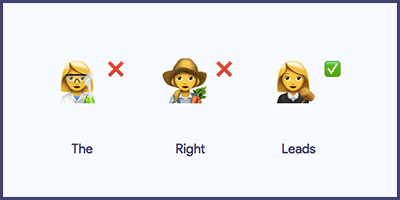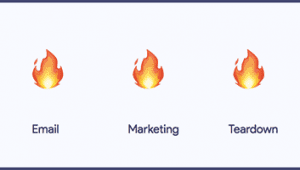How to Find Inbound Content Marketing Topics that Attract the Right Customers
?? ❌
The
?? ❌
Right
?⚖️ ✅
Leads
You decided to use content and search traffic to attract leads and customers to your business.
Great call, but where do you start? You could literally write about anything…. ?
How do you know:
- Whether it will perform?
- If you’ll be able to get traffic within a reasonable timeframe?
- If your content will attract the right leads and prospects?
- Whether the readers will signup/buy/engage with your business?
Stressed yet?

None of this needs to be stressful, scary, or even difficult really. In this post we’ll show you how to find inbound content marketing topics to attract your right audience to your site.
What’s so Great About Inbound Content Marketing?
By default, a website gets 0 visits per month.
Sure, there might be search robots, your friends or your spouse visiting, but it won’t be “growing”.

Now, here comes the kicker: If you simply target good keywords with quality content, people will start finding your site, discovering your service, and (if it’s any good) referring it to others. ?
Organic search traffic is scalable and repeatable traffic. It’s also free and typically comes with higher intent (person searches for something → person finds that something → happy outcome for all).
You can establish a good baseline for site traffic with a great content strategy and a series of posts picked up by search engines.
But sure… you can write about anything and get some level of traffic, but this won’t mean that the traffic you’re getting is the one your site and business needs. So, how do you attract the right kinds of folks to your site?
How to Find Inbound Content Marketing Topics
Even if you’re just starting out, you’ll have assumptions you can use:
Who is this site/business/product for?
Think of your end customer; the person you’re really trying to attract, and ask yourself:
- Are they more consumers or business users?
- What’s their common role or job title?
- What are their responsibilities?
- How long have they been working in their company?
- What character traits do they share?
- What are their common objectives?
- What other problems do they share?
- What tasks are they trying to accomplish?
- What are their personal and professional goals?
- How do they measure themselves?
- Who has influence over them?
- Whom do they work with?
- What technology do they use?
- How are decisions made in their company?
- What’s their work like?
- What’s their day like?
- What’s their lifestyle (married, single, urban, suburban, etc.)?
- Are they decision makers?
- Do they have budget? Whom do they have to work with?
- How are they evaluated?
- How comfortable are they with technology?
- How mature is their company?
- Etc. Etc.
The answers to these question will help form the basis for your content persona – the profile of the person you’re trying to attract with your content.
It won’t be perfect, but you can refine it as you learn.
Once you’re starting to get a feel for your target, look for 20 to 30 people that match that description; people you’d like your content to attract and convert:

Go through their LinkedIn, Twitter, Medium or Pinterest profiles; any platform where they might have left clues as to the types of content they read.
Look for:
- Content shared;
AND - Content liked, favorited, upvoted, pinned, or whatever the site’s equivalent may be.
I like going through the ‘All Activity’ tab on LinkedIn for this (Profile > View All Activity):

Take note of the content pieces and topics:

You should be able to see patterns if the 20-30 profiles you chose are similar:

To make sure your research is valid, only take note of the content they read and consume. Beware of the content they share for the benefit of their customers like the content they themselves produce.
Bonus Tip: You can also take note of the sites and communities they visit. These platforms will be good places to promote your content, and even maybe perhaps advertise.
Prioritizing Inbound Content Marketing Topics
You can’t write about every topic on your list.
You’ll have a hard time generating real results if you spread your content production too thin. That’s one of the reasons why we (us at Highlights) mostly write about email marketing, growth, landing pages, and analytics; topics that relate to our product.
To help prioritize topics, you can use a search keyword research tool like Ahref, Moz, or SEM Rush. These tools will help you understand how competitive the keywords around the topics you’re exploring really are.
We use a tool called Keysearch, but it’s 100% a personal preference.

To be able to quickly establish a foothold in the content market, you’ll want to:
- Target high-traffic topics with low competitivity;
- Keep your efforts focused on one or two topics at most.
This is so your site quickly tells search engines that it’s about ‘INSERT_TOPIC_YOU_SELECT_HERE’.
Although we’ll cover this approach in greater details in a future post, what you’re trying to create is a topic cluster – one clear topic e.g. email marketing supported by a series of secondary (but related) topics e.g. list management for email marketers).
Search engines like Google have changed their algorithm to favor topic-based content. As a result, focusing on topics instead of keywords will get you better results faster; your posts will build off each other, establish a clear related content hierarchy, and raise your overall search traffic.
Here’s what HubSpot has to say about topic clusters:
Evaluating Inbound Content Marketing Topics
Although it will take time for your inbound content marketing topic to reach peak performance, you can get a feel for it relatively quickly.
As you create content, keep an eye on organic search performance; looking specifically at:
- Conversions: Do visitors convert? Does it feel like an acceptable conversion rate?
- Quality: Do buyers find value in the product? Do signups end up engaging with the product? Do leads buy when you call?
This can be easily monitored with Highlights if you have Google Analytics goals in place, but you can also use Google Analytics reports to get the data. For the evaluation, the key is to keep an eye on quality.
Note: We’ll dive deeper into evaluating whether a website attracts the right leads and customers in a future post, sign up to our newsletter to make sure you don’t miss out!
Going Back to Improve Underperforming Content
So, what if it doesn’t work?
Google has a mind of its own, so having underperforming content is completely normal.
With organic traffic, you get a direct – it takes 5 to 10 days – feedback loop: Do it well and you get an an increase in traffic. Do it unsuccessfully, and you’ll see next to no new traffic.
Ideally you want all your posts to be what Brian Massey of Conversion Sciences labels an Eagle (Read: 8 Posts That Affect Your Blog's Organic Traffic); a post that gradually grows in reach and traffic:

… and avoid the dreaded Burp and Fizz; an initial bump in traffic with little to no supporting organic search traffic:

With Highlights you can find the posts that got picked up by search engines and the ones you can improve in seconds.
When a post underperforms for the keywords you had targeted, simply reposition it.
Your inbound content marketing won’t be perfect from day 1, but if you focus on topics that resonate with your target customers, your traffic baseline and quality monitoring, your site traffic and conversions will grow.





Trackbacks & Pingbacks
[…] you have a clear view of your ideal customers, it becomes easier to create content that’s relatable and engaging. As a result, real people will […]
Leave a Reply
Want to join the discussion?Feel free to contribute!